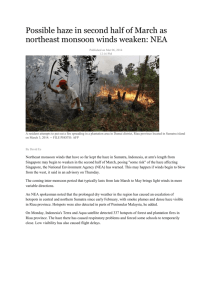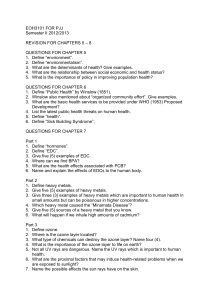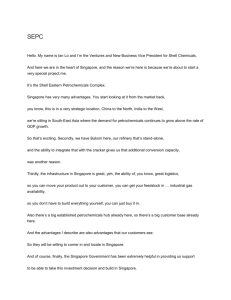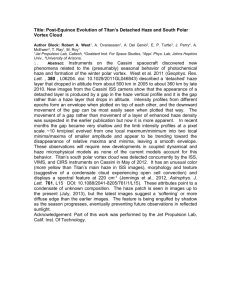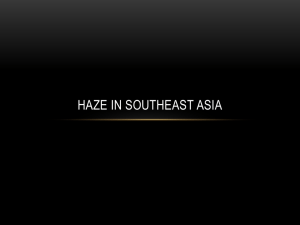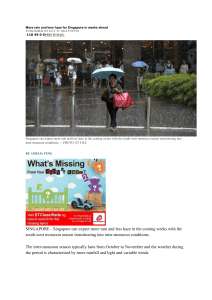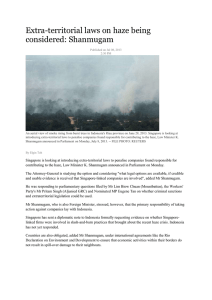Hazards and Management - Singapore A Level Geography
advertisement
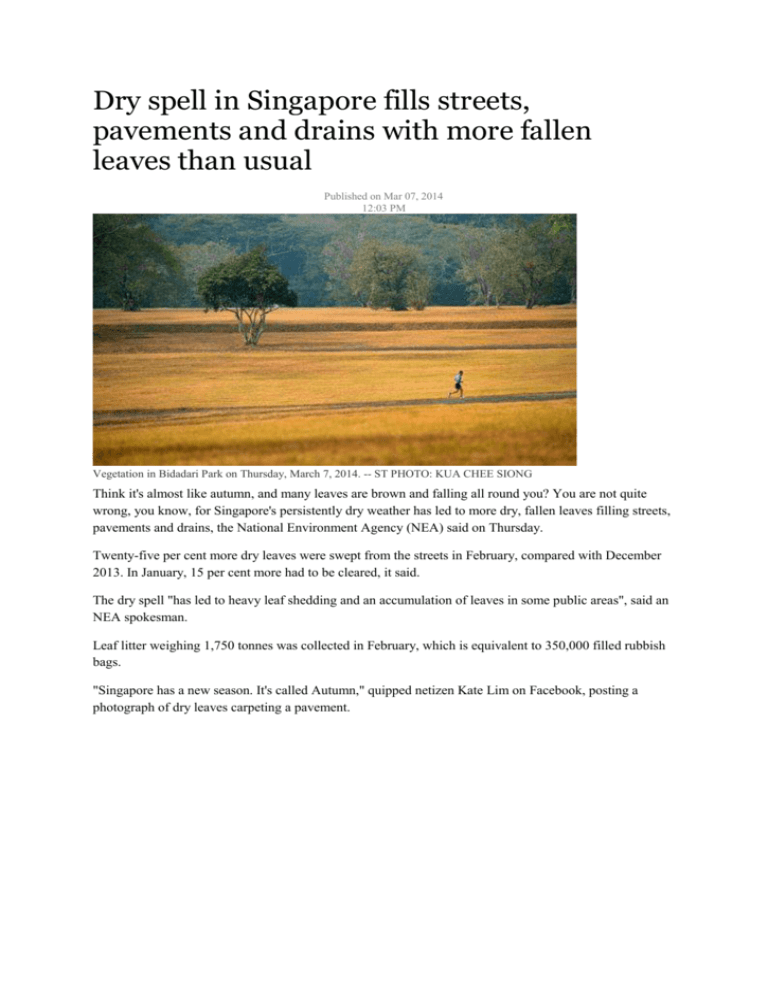
Dry spell in Singapore fills streets, pavements and drains with more fallen leaves than usual Published on Mar 07, 2014 12:03 PM Vegetation in Bidadari Park on Thursday, March 7, 2014. -- ST PHOTO: KUA CHEE SIONG Think it's almost like autumn, and many leaves are brown and falling all round you? You are not quite wrong, you know, for Singapore's persistently dry weather has led to more dry, fallen leaves filling streets, pavements and drains, the National Environment Agency (NEA) said on Thursday. Twenty-five per cent more dry leaves were swept from the streets in February, compared with December 2013. In January, 15 per cent more had to be cleared, it said. The dry spell "has led to heavy leaf shedding and an accumulation of leaves in some public areas", said an NEA spokesman. Leaf litter weighing 1,750 tonnes was collected in February, which is equivalent to 350,000 filled rubbish bags. "Singapore has a new season. It's called Autumn," quipped netizen Kate Lim on Facebook, posting a photograph of dry leaves carpeting a pavement. The agency has stepped up cleaning efforts. But it is not easy, as the increased and repeated leaf fall has meant that cleaners take a longer time to clean areas, said the spokesman, while the areas may give a "perception of incomplete or inadequate cleaning". The greater frequency of falling leaves may also mean a higher risk of mosquito breeding, as the Culex mosquito - which does not carry the dengue virus - breeds in stagnant water with high content of organic matter from plants. The NEA has thus stepped up the pace of cleaning during this period in dengue cluster areas and areas with high numbers of mosquitoes, in particular private estates with open drains. It has also arranged for additional cleaning at 71 locations, and is working with national water agency PUB to step up monitoring along drains at 108 locations. Town councils and land agencies are also increasing their frequency of drain cleaning to prevent leaf litter building up, the spokesman said. These efforts would help reduce potential mosquito breeding grounds, he said. Some 250 of these were detected in the middle of last month, compared with just 30 in the beginning of January. Air quality index in moderate range, as Singapore experiences slight haze Published on Mar 07, 2014 7:06 PM A slight haze is seen in the Dover Road area at 5.20pm on Thursday, March 7, 2014. -- PHOTO: JESS THIA Air quality in Singapore yesterday reached its worst level since the start of the year, with the haze affecting visibility in some areas and leaving a smell of smoke. The Pollutant Standards Index's (PSI) three-hour reading had gone from "good" - 31 at 9am - to "moderate" by 6pm, hitting a high of 71 at 8pm and falling to 61 two hours later. On Thursday, the National Environment Agency (NEA) said that the transition from the Northeast Monsoon to the inter-monsoon period in the second half of March "may pose some risk of transboundary haze affecting Singapore". The Riau province of Sumatra has been shrouded in dense haze over recent days as farmers set fires to clear land during the dry spell. On March 5, NEA detected six hotspots in Sumatra, Indonesia and 47 hotspots in peninsular Malaysia. But it added that the low hotspot count for Sumatra was due to cloud cover and partial satellite coverage. Singapore is in the midst of one of its longest spells of dry weather in years, with barely any rain over the past month and a half. NEA said it will continue to monitor the situation and provide updates. These can be accessed from NEA's Facebook and Twitter accounts and also at the haze microsite at www.haze.gov.sg. Civil groups air their views on proposed transboundary haze law Published on Mar 07, 2014 9:45 PM Civil society experts and leaders of non-government organisations met on Friday afternoon to share their perspectives and recommendations on the proposed Transboundary Haze Pollution Bill. The new Bill, which is up for public consultation till March 19, would hold companies and other entities liable for fires on their land outside Singapore which caused transboundary haze in Singapore, and provides for both criminal and civil liability. The new law is being proposed after Singapore's worst-ever bout of haze last June, and just as dry weather has led to hazier conditions. On Friday evening, the 3-hour Pollutant Standards Index reached 71, in the 'moderate' range. At the session, organised by the Singapore Institute of International Affairs think-tank at its Dhoby Ghaut premises, the 11 participants from think-tanks, universities, and NGOs like BirdLife International discussed the practical challenges of the new law. For one thing, serving notice to those based overseas may be challenging, they said. And if businesses moved overseas in response, Singapore would have even less sway over them. They also discussed whether the proposed fines were high enough, and were divided on whether there ought to be incentives and protections for whistleblowers. For instance, one expert suggested that the fine should be a function of how much land area is burned, so companies are not encouraged to simply burn large swathes at one go. SIIA chairman Simon Tay said feedback from the two-hour session would be compiled and submitted to the Ministry of the Environment and Water Resources. "Singapore's reputation is about enforcing the laws that it talks about, and this proposed bill shows that Singapore is willing to do its part to help solve the haze. But the question now is how this bill is going to be enforced justly," he said.
